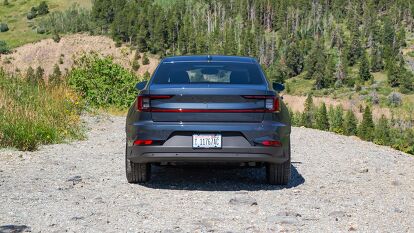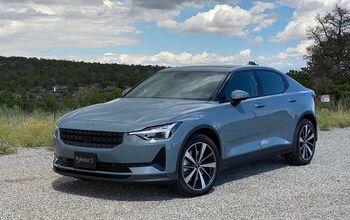2024 Polestar 2 Review: First Drive


Love It | Leave It |
|---|---|
Big range gains | Dual Motor sticks to old battery |
Rear-drive brings the fun | Middling infotainment |
Big value for money | Seats lack bolstering |
Evolution is the name of the game at Polestar.
The start-up brand is on the verge of greatly expanding its lineup here, not only with the upmarket 3 SUV, but the more compact and affordable 4. After that, it’s back into clear six-figure territory with two EV sports cars targeting no less than the Porsche Taycan.
But the Polestar 2 is the bedrock of the brand’s foundation here in North America. Launched in late 2020, the high-riding sedan has come in for a round of updates for 2024. Rather than a stylistic exercise, however, this mid-cycle freshening up focuses on tech and efficiency, with a major change under the skin of the entry-level Polestar 2 that’s unexpected—and welcome.
What’s new?

The Long Range Single Motor (LRSM) 2 sees the biggest changes for 2024. In a rare move, the car switches from front- to rear-wheel drive. The swap allows for a stronger synchronous permanent magnet motor, along with updated inverters; outputs jump to 299 horsepower and 361 pound-feet of torque, improvements of 68 and 118, respectively. More than a sheer numbers game, the move to rear-drive promises improved dynamics, which we’ll find out in a bit.
The LRSM also sees a new, slightly larger-capacity battery pack. Supplier CATL provides an 82-kWh pack, 79 kWh of which are usable. It’s still a 400-volt lithium-ion setup, but can now hit up to 205 kW of DC fast-charging, making it one of the quickest on the market.

The dual-motor 2 continues to use the smaller 78 kWh (75 kWh usable) battery pack from LG Chem. It tops out at 155 kW of charging speed. The trade-off here is an extra driven axle and more power: the standard Dual Motor 2 now produces 421 hp and 546 lb-ft. Both of those figures are up over the 2023 model, too. The Performance Pack now bumps the pony count to 455 hp, with torque staying the same. Eagle-eyed readers will note that’s a slight decrease in horsepower over the 2023 Perf Pack. A company spokesperson explained that the company saw the same levels of performance during testing—remember, still more torque—and that determined the drop.
Range sees a huge jump for the single-motor model, now sitting at 320 miles (515 kilometers). The regular dual-motor also has ekes out 16 more miles (26 km), now 276 miles (444 km) on a single charge. The Performance Pack’s bigger wheels and stickier tires knock that down to 247 mi (397 km).

Beyond all the nitty-gritty, you’ll find a new body-colored grille insert for 2024. This houses SmartZone, Polestar’s mid-range radar array which first debuted on the upcoming Polestar 3 SUV. Speaking of the latest model, the Perf Pack 2’s redesigned wheels are inspired by the 3’s rolling stock.
Single motor shines

Enough numbers: we’ve got a squiggly drive route up into the foothills west of Denver to attend to. The day starts in the new Single Motor 2. It takes just one punch of the accelerator to know this is a much quicker car than before. Polestar quotes a 5.9-second dash to 60 mph (96 km/h), over a second better than before, but here at 8,000 feet above sea level the 2 feels quicker still. It will easily reel in dawdling traffic on the highway. The dramatic increase in torque just wouldn’t have been possible with front-wheel drive, either.
There’s a better balance now too, the 4,429-pound sedan riding with a tight, controlled character better in-line with Polestar’s premium status. Want to swing the tail out? The 2 will oblige, though the electronic nannies will step in pretty abruptly. There are no selectable drive modes, though pilots can choose from three levels each of steering weight and regenerative braking. The lightest helm feels too vague: no effort, but no fun. The heftiest is still light to my tastes, but feels best—I see little reason for the middle setting. Regenerative braking ranges up to reasonably strong, offering a full one-pedal experience. Best of all, these settings persist through use cycles, so you don’t have to re-set everything every drive.
Dual motor still impresses

After lunch, we turn around to do the same route back into Denver—or at least, so we thought. The native Google Maps ends up taking us on a different, even twistier route, one with tight switchbacks and a moose to keep an eye on speeds. It’s Perf Pack dual-motor time.
Even the added 200-odd pounds of the dual-motor setup doesn’t dull the straight-line surge. This 2 is genuinely quick, blitzing the run to 60 mph (96 km/h) in a blink over 4 seconds. In the corners, the weight does make the car slightly less keen on turn-in, though the upsized 20-inch Continentals find more purchase once committed. The trade-off is slightly more tire noise from inside the cabin, but that’s about it. I appreciate the simplicity here: no umpteen selectable soundtracks, just a light whirrrr as the 2 breezes from corner to corner. Four-piston Brembo brakes ensure this dual-motor has added stopping power to match the go, and pedal feel is good.
My drive partner and I managed 34.6 kWh per 100 miles in the DM (21.5 kWh / 100 km). The single-motor fared better, even with a route predominantly uphill, at 28.3 kWh / 100 mi (17.6 kWh / 100 km). This aligns with what the spokespeople were saying before the drive: there is no special model designed for hitting those range numbers—it’s all achievable pretty easily.
Comfy cabin

The Polestar 2’s cabin remains a calming, comfortable place to spend time. It’s quite simple in design, with a clean dashboard design that emphasizes the width of the cabin. The dual-motor tester comes with the upgraded Nappa leather interior, which not only feels great, but comes paired with nicely textured light ash wood trim. The power adjustable seats have a memory feature and a manually adjustable thigh support. Checking the box for the leather unlocks front ventilated seats, which are very useful on this 90-degree day. If there's an issue with the thrones, it's one of support: the 2 eggs its driver on, but the seats lack the necessary bolstering for more spirited driving.
The big support bars framing the center console are well-secured, and feature a nice plinth of wood on their inner edges. The entire center console is piano black, which remains one of the few disappointments inside the otherwise tasteful cabin. I wouldn't say no to a handful of buttons down here instead of smudge city; it'd make handling the infotainment system a little easier.

Polestar has steadily improved that big, portrait-style screen. It's sharp and quick to respond, and (finally) has wireless Apple CarPlay and Android Auto support, to go along with the now-standard wireless charging pad. There's just too much reliance on the screen, particularly in regards to climate controls. That being said, props to Polestar for having an easy-access volume page that covers every audio source. More of this, auto industry.
Passenger space is good up front and okay out back; the roofline puts a premium on second-row headspace. At least folks back there get their own climate controls and heated outboard seats, plus charging slots. Storage space is also great: there's a small frunk for stowing charging cables, while the trunk itself has a clever two-level setup, with the lowest section large enough to swallow two sizeable messenger bags.
Safety has long been a priority at Volvo and thus, Polestar. The 2 includes a blind-spot monitoring system, steering assist, cross-traffic alert, parking assist, and regular cruise control. Newly standard on all trims this year are automatically dimming side mirrors and a 360-degree camera. Buyers need to pony up for the Pilot package to unlock adaptive cruise control, however.
2024 Polestar 2: pricing and availability

Given the improved performance and range, never mind the additional standard tech, the 2024 Polestar 2’s starting price of $51,300 ($57,450 CAD) including destination is a bargain. That’s a little over a grand more than the ’23 on either side of the border. Better still, the 2 qualifies for the IRA Clean Vehicle credit in the US as well as federal and provincial iZEV incentives in Canada.
Stepping up to the 2 Long Range Dual Motor bumps the sticker to $56,700 ($65,450 CAD). The Pilot pack, now standard on the Dual Motor but optional on the Single Motor, accounts for $2,000 ($2,900 CAD) of that alone. Polestar has streamlined the options list: Plus adds useful creature comforts such as the pano roof, memory seating, two-level trunk, digital key, and a heat pump. The light Nappa leather option ($4,000 / $5,000 CAD) requires the Plus pack, and bundles front-seat ventilation along with the softer surfaces. Other than the dual-motor-only Perf Pack, the only other available cost options are metallic paint and 20-inch alloys.
Final Thoughts: 2024 Polestar 2 First Drive Review

On first impressions, Polestar has refined its first mass-production model into a star this year. The 2024 Polestar 2 is a well-priced, fun-to-drive premium EV four-door, particularly in single-motor guise.
Those craving the ultimate performance will still gravitate towards the Perf Pack, which turns this sedan into one of the stealthiest sleepers on sale today. But unless you need those bragging rights—and until the updated battery pack finds its way into the dual-motor, a supplier issue for now—I’d argue the single-motor is the better buy.
Become an AutoGuide insider. Get the latest from the automotive world first by subscribing to our newsletter here.
2024 Polestar 2 | |
|---|---|
Motor: | 1 x Electric motor (AWD: 2x) |
Battery Capacity: | 79 kWh (AWD: 75 kWh) |
Outputs: | 299 hp, 361 lb-ft (AWD PP: 455 hp, 546 lb-ft) |
Transmission: | 1AT, RWD/AWD |
US Fuel Economy (MPGe): | 124/106/115 (RWD), 100/90/95 (AWD PP) |
CAN Fuel Economy (Le/100 km): | 1.9/2.2/2.0 (RWD), 2.4/2.6/2.5 (AWD PP) |
Range: | 320 mi / 515 km (RWD), 247 mi / 397 km (AWD PP) |
Starting Price (USD): | $51,300 (inc. dest.) |
As-Tested Price (USD): | See text |
Starting Price (CAD): | $57,450 (inc. dest.) |
As-Tested Price (CAD): | See text |

Kyle began his automotive obsession before he even started school, courtesy of a remote control Porsche and various LEGO sets. He later studied advertising and graphic design at Humber College, which led him to writing about cars (both real and digital). He is now a proud member of the Automobile Journalists Association of Canada (AJAC), where he was the Journalist of the Year runner-up for 2021.
More by Kyle Patrick








































































Comments
Join the conversation
Great writing.